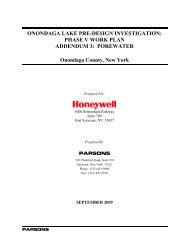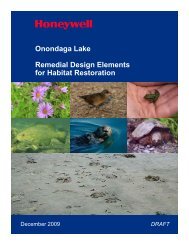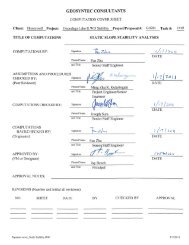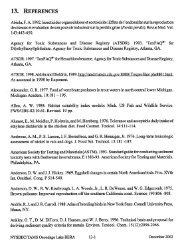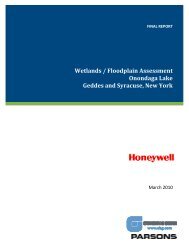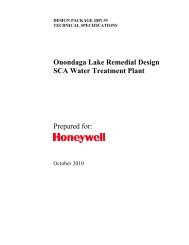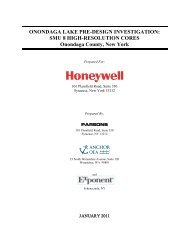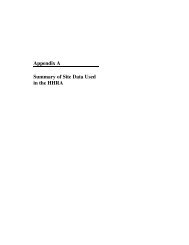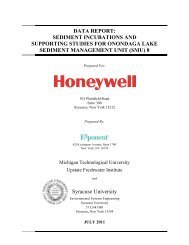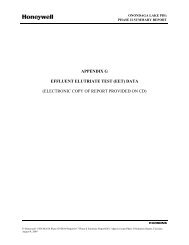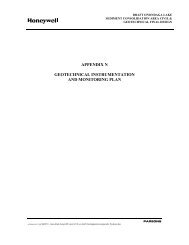Phase 1B Underwater Archaeological Report for the Onondaga ...
Phase 1B Underwater Archaeological Report for the Onondaga ...
Phase 1B Underwater Archaeological Report for the Onondaga ...
Create successful ePaper yourself
Turn your PDF publications into a flip-book with our unique Google optimized e-Paper software.
FINAL<br />
<strong>Phase</strong> IB <strong>Underwater</strong> <strong>Archaeological</strong> Resources <strong>Report</strong> <strong>for</strong> <strong>Onondaga</strong> Lake Superfund Site<br />
ONONDAGA LAKE MARITIME CONTEXT<br />
<strong>Onondaga</strong> Lake was <strong>for</strong>med following <strong>the</strong> retreat of continental glaciers and proglacial Lake Iroquois<br />
approximately 10,000 to 8,000 years be<strong>for</strong>e present (BP). At a current elevation of 363 feet (110.6<br />
meters [m]) above sea level (ASL) it is part of <strong>the</strong> Oswego River drainage that flows into Lake Ontario.<br />
The lake is currently 4.6 miles (7.4 kilometers [km]) long with a maximum width of one mile (1.6km).<br />
<strong>Onondaga</strong> Lake outflows to <strong>the</strong> Seneca River, which joins <strong>the</strong> Oneida River at <strong>the</strong> Three Rivers junction<br />
at Phoenix, New York, to <strong>for</strong>m <strong>the</strong> Oswego River, a major tributary of Lake Ontario. <strong>Onondaga</strong> Lake has<br />
a surface area of 4.5 square miles (12 square kilometers [km 2] ), a volume of 35 billion gallons (132.5<br />
billion liters), and a maximum depth of 64 feet (19.5m). 8 The level and shoreline of <strong>Onondaga</strong> Lake have<br />
changed over <strong>the</strong> past 10,000 to 8,000 years due to climate fluctuations, human modifications and<br />
seasonal variations. It is important to understand <strong>the</strong>se changes and how <strong>the</strong>y influenced human<br />
habitation around <strong>Onondaga</strong> Lake in order accurately study <strong>the</strong> maritime context of this inland lake.<br />
POST-GLACIAL LAKE LEVEL FLUCTUATIONS IN NORTHEASTERN NORTH AMERICA<br />
As part of <strong>the</strong> larger Great Lakes drainage basin, <strong>Onondaga</strong> Lake was <strong>for</strong>med during <strong>the</strong> deglaciation of<br />
nor<strong>the</strong>rn North America circa 12,000 BP. While similar post-glacial lakes and ponds in <strong>the</strong> nor<strong>the</strong>astern<br />
United States have not been <strong>the</strong> subject of thorough archaeological study with regards to submerged<br />
precontact resources, many have been <strong>the</strong> subject of paleoenvironmental studies that evaluated <strong>the</strong><br />
effects of Holocene climatic change on lake levels. These changes in <strong>the</strong> location and/or presence of<br />
shorelines and wetlands influenced precontact human settlement patterns and resource procurement<br />
strategies. Studies in <strong>the</strong> Great Lakes, Finger Lakes and smaller ponds of <strong>the</strong> nor<strong>the</strong>astern United States<br />
and sou<strong>the</strong>rn Ontario have demonstrated that climate change throughout <strong>the</strong> early and mid-Holocene<br />
(circa 10,000-4,000 BP) had diverse effects on lake level fluctuations in <strong>the</strong> Nor<strong>the</strong>astern section of <strong>the</strong><br />
continent, as well as <strong>the</strong> distribution and <strong>for</strong>mation of wetlands along <strong>the</strong> margins of <strong>the</strong>se lakes and<br />
<strong>the</strong>ir tributaries (Figure 3). 9<br />
Sediment core studies in <strong>the</strong> Finger Lakes have shown that during <strong>the</strong> Holocene Hypsi<strong>the</strong>rmal climatic<br />
period (9000 to 4000 BP) lake levels were relatively high when compared to <strong>the</strong> drought conditions<br />
proposed <strong>for</strong> <strong>the</strong> Great Lakes and Mid-West region. 10 This study also indicated that <strong>the</strong>re were a series<br />
of low stands during <strong>the</strong> Hypsi<strong>the</strong>rmal in <strong>the</strong> Finger Lakes region every 1800 to 2200 years<br />
(approximately 9,800, 7,800, 6,000, 4,200 and 2,000 BP) with <strong>the</strong> highest relative lake levels occurring<br />
circa 8,800 and 7,000 BP. 11 Sediment core and subbottom profiler data analyses at small closed basin<br />
ponds in Maine suggest that <strong>the</strong>re was a 7 to 20 foot (2 to 6m) decline in lake levels during <strong>the</strong> mid-<br />
Holocene, especially circa 6,000 BP. 12 Sediment cores from Craw<strong>for</strong>d Lake in sou<strong>the</strong>rn Ontario indicate<br />
<strong>the</strong> most significant lake low stand was between 4,800 and 2,000 BP, which is consistent with o<strong>the</strong>r sites<br />
in sou<strong>the</strong>rn Michigan and Ontario. 13 Within <strong>the</strong> Great Lake Basins <strong>the</strong>re were several phases of drier<br />
climate and lake low stands, including a major event that spanned ca. 9,000 to 4,000 BP. 14 During <strong>the</strong><br />
Lake Stanley phase (7,900 BP) water levels in <strong>the</strong> Lake Huron basin were up to 230 to 328 feet (70 to<br />
100m) below present and large areas of lake bed were exposed terrestrial landscapes. 15 While all of<br />
<strong>the</strong>se studies demonstrate that lake level changes throughout <strong>the</strong> early to mid Holocene were prolific in<br />
<strong>the</strong> nor<strong>the</strong>ast, <strong>the</strong>y also indicate that <strong>the</strong> impacts of climate change on lake levels varied depending<br />
upon <strong>the</strong> specific body of water in question.<br />
To date, <strong>the</strong>re has been no in-depth paleo-environmental study of <strong>Onondaga</strong> Lake to gauge how lake<br />
level fluctuation impacted precontact human settlement around <strong>the</strong> lake. Though <strong>the</strong> studies<br />
4



